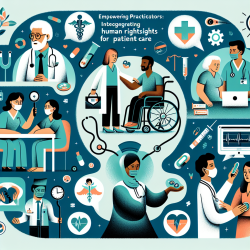Understanding Human Rights in Patient Care
HRPC brings human rights principles into health care delivery, addressing the rights of both patients and health care providers. Unlike the concept of "patients' rights," HRPC is not merely about consumer transactions but is rooted in human dignity. It also acknowledges the dual loyalty of health care providers, who often face simultaneous obligations to patients and other parties, such as the state.
The special collection highlights several key areas where HRPC can be applied:
- State responsibility in private health facilities
- Reproductive health
- Palliative care
- Intersections with public health
- Particular populations, including Roma, people who use drugs, and transgender persons
Practical Applications for Practitioners
For practitioners, integrating HRPC into their practice involves understanding and applying the legal obligations and human rights norms that govern patient care. Here are some actionable steps based on the research:
1. Educate Yourself and Your Team
Understanding the legal framework surrounding HRPC is crucial. Practitioners should familiarize themselves with Practitioner Guides, which offer detailed, practical advice on both litigation and alternative mechanisms for protecting patient and provider rights. These guides are developed by interdisciplinary teams of lawyers, doctors, and international experts.
2. Advocate for Safe Working Conditions
Health care providers often face unsafe working conditions and sanctions for providing evidence-based care. Advocacy for safer working environments and independence in clinical decision-making is essential. Practitioners can use HRPC principles to push for systemic changes that protect both patients and providers.
3. Implement Patient-Friendly Materials
Providing patients with easy-to-understand information about their rights and remedies is a key aspect of HRPC. Collaborate with community partners to create and distribute these materials, ensuring they are tailored to marginalized populations.
4. Engage in Continuous Learning and Training
Human rights education for health professionals can lead to significant changes in behavior and culture within health care settings. Engage in continuous learning and training programs that focus on HRPC principles and their practical application.
5. Participate in Advocacy and Community Mobilization
Advocacy and community mobilization are critical components of HRPC. Practitioners should actively participate in initiatives that promote human rights in patient care, working alongside community leaders and organizations to drive systemic change.
Encouraging Further Research
The special collection underscores the importance of ongoing research and scholarship in the field of HRPC. Engaging in research allows practitioners to explore new dimensions of HRPC and contribute to the evolving body of knowledge. By participating in research, practitioners can help develop innovative solutions to the challenges faced in health care settings.
For those interested in delving deeper into the subject, the special collection provides a comprehensive overview of HRPC and its various applications. To read the original research paper, please follow this link: Human rights in patient care: a special collection.
Conclusion
Integrating HRPC principles into health care practice can lead to more equitable and compassionate care for all patients. By educating themselves, advocating for better working conditions, implementing patient-friendly materials, engaging in continuous learning, and participating in advocacy, practitioners can significantly improve the quality of care they provide.
As we move forward, let us remember that health care settings should be places of care, respect, and dignity for everyone.










